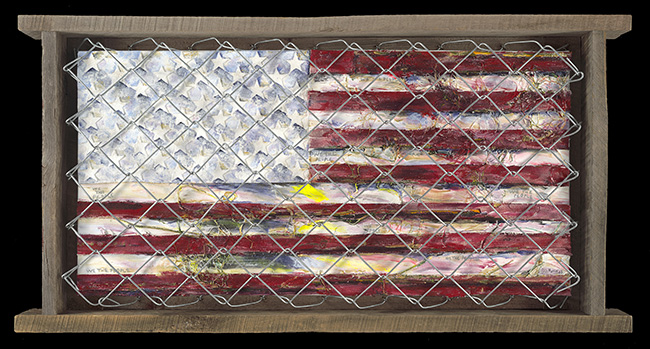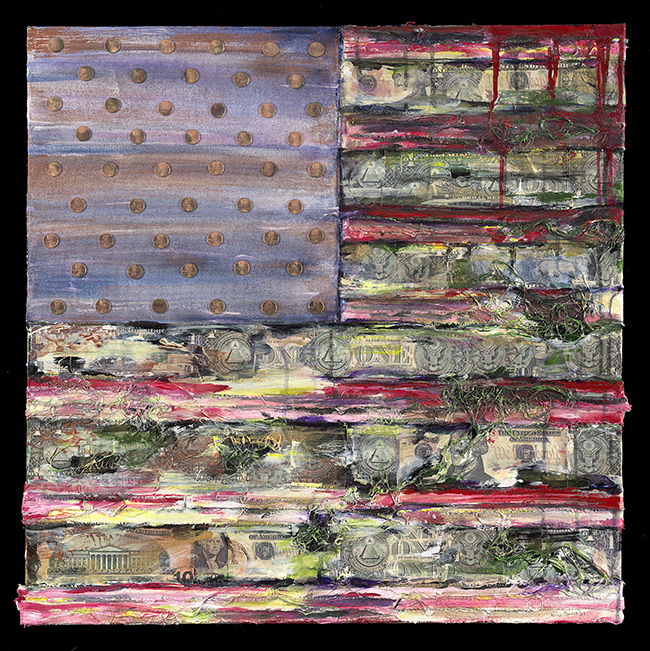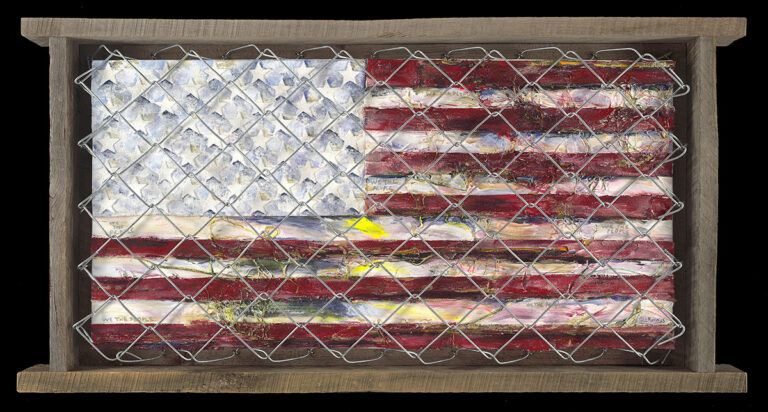L. Scooter Morris, a sensory illusionist, transforms fleeting experiences into works that feel both immediate and enduring. Her paintings are less about replicating what the eye sees and more about what the mind and body register in a single moment. She captures the shimmer between perception and memory, distilling everyday encounters into images that echo something larger than life.
Her practice revolves around what she calls “Sculpted Paintings.” These works are layered with texture, shifts of light, and subtle depth that move beyond flat surface. Through acrylics and mixed media, Morris builds paintings that carry a tactile resonance—artworks that ask to be experienced, not just looked at. More than decoration, her work opens space for reflection on the times we live in. It addresses questions of equity, justice, and shared humanity, while never losing sight of beauty. For Morris, the aesthetic and the ethical are bound together.

“Of Our Own Making” (2023, Acrylic and Mixed Media, 19”x37”)
This piece feels like a mirror held up to human choices. The surface carries the energy of layered paint, each stroke pressed against another, almost like sediment. There’s no neutral ground here—the textures push forward, demanding attention. “Of Our Own Making” suggests consequence, the way actions pile upon each other until a pattern emerges.
What’s compelling is how Morris uses her medium to echo responsibility. Acrylic and mixed media allow for contrasts: smooth planes against rough ridges, light bouncing off glossy surfaces while matte areas absorb it. This tension mirrors the contradictions of human behavior—our capacity to create, to destroy, to renew. The painting doesn’t lecture. Instead, it offers a space where the viewer can sense weight, almost physically, of what has been built and left behind.
The horizontal format (19”x37”) stretches the scene like a landscape, but not a natural one. It is a constructed terrain, shaped by human hands. There is both a warning and an invitation in the work. Morris seems to ask: if this is of our own making, what next will we choose to make?

Dark Money Pulls Strings” (2023, Acrylic and Mixed Media, 30”x30”)
Where “Of Our Own Making” speaks to collective consequence, “Dark Money Pulls Strings” turns its gaze to hidden power. The title sets the stage before color or texture even enters the frame. This painting reveals influence that operates beneath the surface, unacknowledged but potent.
The mixed media approach gives Morris a way to dramatize control. Certain areas feel dense, almost heavy, while others are threadlike, stretched thin—as though strings really run across the surface. The push and pull between elements mimics manipulation: some parts dominate, others are left slack. The square format (30”x30”) traps the composition in a balanced frame, but the content resists equilibrium. Instead, the painting vibrates with imbalance, a reminder that control rarely looks fair.
Morris is not heavy-handed in her symbolism. The work could be viewed purely for its visual dynamics—lines crossing, textures colliding—but once the title is known, the imagery sharpens. It becomes impossible not to think about money’s hidden channels, about the way influence can distort justice and equity.
Dialogue Through Art
Both paintings come from the same year, 2023, yet they converse across different registers. “Of Our Own Making” reflects broadly on collective responsibility, while “Dark Money Pulls Strings” points directly to systems of power. One feels expansive, the other claustrophobic, but together they highlight Morris’s interest in the relationship between the personal and the political.
Her process of sculpting paint—building layers, working surface against surface—becomes a metaphor for how society is built. Nothing happens in isolation. Each action leaves residue. Each decision reshapes the landscape. The beauty of her work is that it is not just about critique. There is also resilience in the layers, evidence that creation and renewal are always possible.
Morris positions her art as a site of conversation. These are not silent paintings. They press viewers to pause, to notice textures, to read titles, and to think about the parallels between material surface and social fabric. In doing so, she merges aesthetic intensity with ethical urgency.
Conclusion
L. Scooter Morris’s “Sculpted Paintings” live in the tension between beauty and meaning. They carry the weight of social commentary but never lose their visual allure. “Of Our Own Making” and “Dark Money Pulls Strings” are different in form and focus, yet both underline her larger project: transforming fleeting sensations and urgent truths into lasting works of art.
By working with acrylic and mixed media, Morris crafts paintings that feel alive, shifting with the light and the angle of approach. They remind us that perception is fluid, reality layered, and our choices—both personal and collective—always leave a trace.

